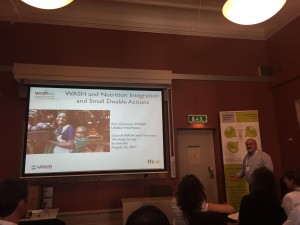Diving deep into WASH and nutrition
August 26, 2015
In my last blog post I wrote that one of the ways we would be successful post 2015 would be through working with other sectors. It is thus fitting that integration between WASH and nutrition was a major focus of my day today.
The SuSanA WASH and Nutrition Working Group hosted two sessions on this topic. In the first session I engaged with a group exploring how WASH and nutrition can be operationalized through policy, strategy, and advocacy. While some disagreements occurred during this robust small group discussion, ultimately I took away three key points about WASH and nutrition.
First, we should pursue solutions that are impactful and cost-effective. A cliché in the business world is to “work smarter, not harder,” and the same mentality could be applied to development by integrating in a synergistic manner. Oftentimes integration is found in unlikely places, and promoting simple steps on the way to an ideal behavior, as USAID’s WASHplus project does with its small doable action approach, is a good way to foster integration among similar interventions.
Second, the local perspective must be incorporated. Scaling up WASH and nutrition programs will not be successful if the local context is not robustly incorporated. From engaging the political process (encouraging ministers to work together, for example) to exploring local funding mechanisms, we know that a one-size-fits-all approach will not work. This is not to say that there are not applicable lessons learned or similarities across contexts, but local stakeholder engagement is crucial.
These first two components should be augmented by evidence. Integration for the sake of integration alone would be a mistake. We have some ideas about what works, and what doesn’t, but we need more evidence. Through the PPPHW’s involvement with the Clean, Fed & Nurtured Community of Practice, we are exploring exactly that question in the context of WASH, nutrition, and early childhood development.
Challenges were also mentioned throughout the day. For instance, if you look around World Water Week very few, if any, nutrition sector experts are in attendance. Different sectors speak different languages, so while we may be talking about the same objectives we do so in foreign ways. These barriers mean that oftentimes we are missing opportunities or duplicating work. Clearly, engaging with other sectors cannot occur within the walls of WASH alone, but the “how” of this isn’t always obvious or easy.
One participant remarked in the second event, “The Holy Grail for us is not WASH or nutrition. It is improved health.” Ultimately, we are all working toward disease reduction, decreased child mortality, and improved opportunities for children to grow, develop, and thrive. We may do so in different ways, but it is evident that integration is the way forward.
Do you have experience in integrating WASH and nutrition? What lessons or thoughts do you have on the topic that might be useful to others? Join the conversation on Twitter by tweeting @HandwashingSoap.
